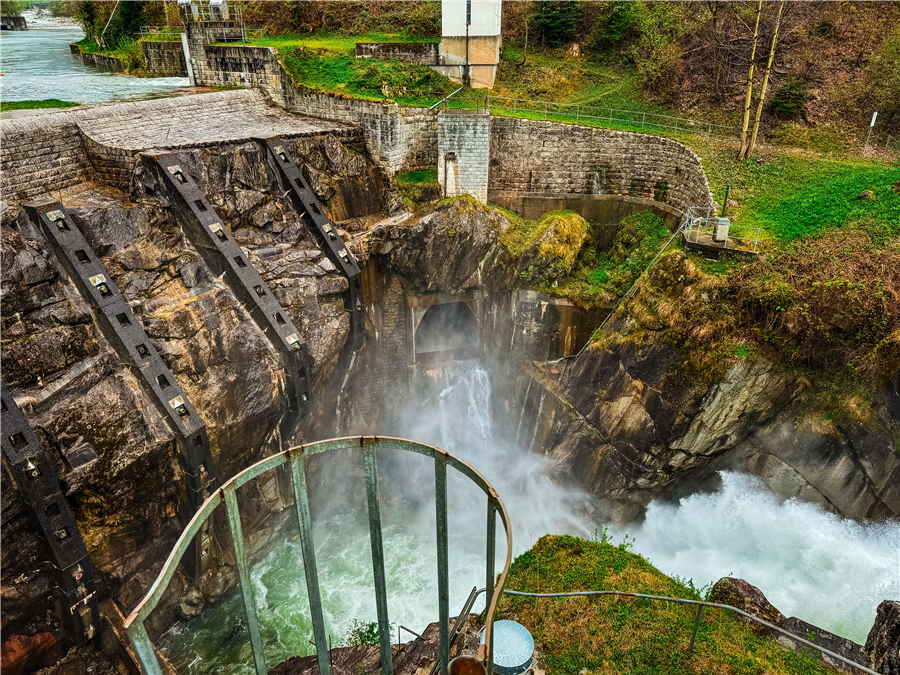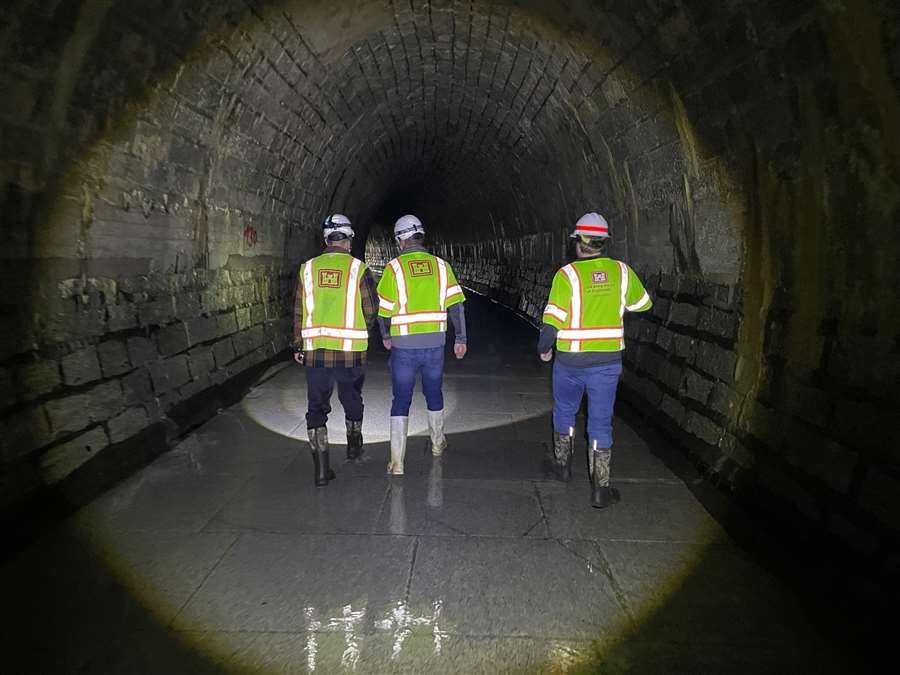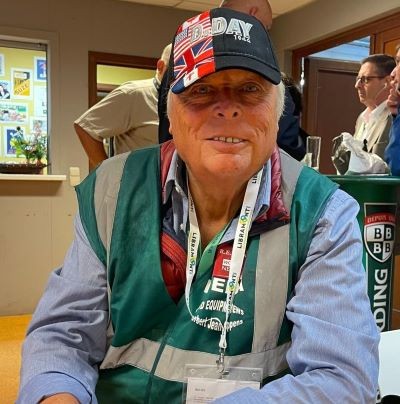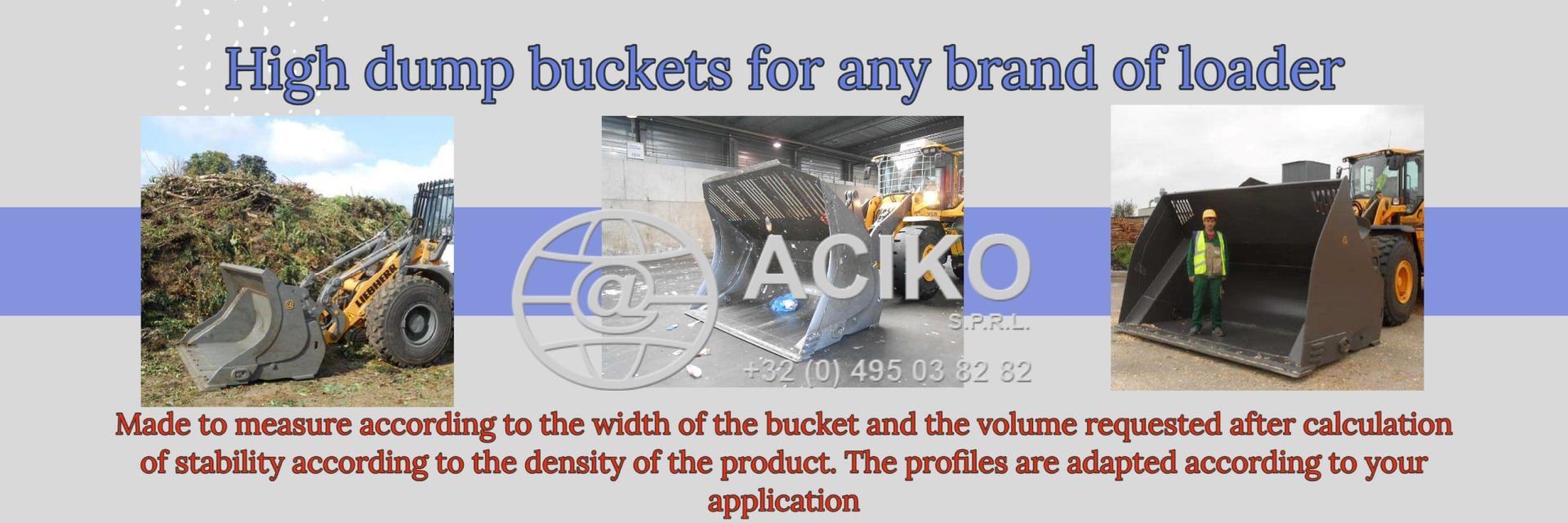R.E.News International-US Army engineers visit Switzerland to prep for project
 02/09/24-FR-English-NL-footer
02/09/24-FR-English-NL-footer
Des ingénieurs de l'armée américaine visitent la Suisse pour préparer un projet

 The Pfaffensprung sediment bypass tunnel, visible from above the dam and the outlet, in Uri, Switzerland. This infrastructure has been in use for over 100 years and continues to provide flood protection and hydropower for the surrounding communities. (Image: Carly Lynch, USACE – Alaska District)-USACE staff investigate the Pfaffensprung sediment bypass tunnel in Switzerland. (Image: Jesse Brown, USACE – Huntington District)
The Pfaffensprung sediment bypass tunnel, visible from above the dam and the outlet, in Uri, Switzerland. This infrastructure has been in use for over 100 years and continues to provide flood protection and hydropower for the surrounding communities. (Image: Carly Lynch, USACE – Alaska District)-USACE staff investigate the Pfaffensprung sediment bypass tunnel in Switzerland. (Image: Jesse Brown, USACE – Huntington District)
L'armée américaine constate que parfois la meilleure aide vient de loin, comme l'a récemment fait une équipe d'ingénieurs de l'armée américaine qui a rejoint des chercheurs suisses dans les Alpes pour préparer un projet de barrage et de tunnel en Alaska, aux États-Unis.
Des membres du Corps des ingénieurs de l'armée américaine (USACE) de trois districts régionaux ont visité un barrage hydroélectrique isolé dans le canton alpin d'Uri, en Suisse, pour mener des recherches préliminaires pour un projet d'infrastructure à venir près de Seward, en Alaska : le projet de dérivation des crues de Lowell Creek (LCFD).
« Le personnel du district d'Alaska [USACE], du district de Seattle et du district d'Omaha a visité le fonctionnement interne du tunnel de dérivation des sédiments de Pfaffensprung, qui fait partie d'un barrage qui retient la rivière Reuss », a expliqué l'armée américaine. « Ce système est utilisé depuis plus de 100 ans et a utilisé des pavés de granit dans le revêtement de son tunnel pendant toute son existence.
« Au fil des décennies, les ingénieurs suisses ont remplacé et réparé les pavés du site, qui comprenaient également un revêtement en acier et du basalte comme matériau de choix. »
L’équipe américaine a également visité un tunnel de dérivation des sédiments au barrage de Solis, près du canton des Grisons.
Que faisaient les ingénieurs de l’armée américaine en Suisse ?
La localité d’Uri (au « cœur des Alpes suisses accidentées », a déclaré l’armée américaine) a été choisie pour son climat et ses similitudes géographiques avec le projet basé aux États-Unis, qui se situe dans une sous-chaîne des Boundary Ranges en Amérique du Nord.
Mais le plus important était l’utilisation de tunnels de dérivation des sédiments.
Coleman Chalup, ingénieur géotechnique et responsable technique du projet LCFD, a déclaré : « Il n’y a pas beaucoup d’endroits dans le monde qui utilisent des tunnels de dérivation des sédiments dans leur infrastructure de barrage. C’est une méthode qui occupe un rôle important là où elle est utilisée, mais elle n’est pas courante. »
Les tunnels de dérivation des sédiments sont plus courants sur les barrages qui rencontrent des débris, tels que le limon glaciaire, un matériau commun dans de nombreuses eaux de l'Alaska. « En cas d'inondation importante sur un barrage de protection, les tunnels sur le site empêchent une accumulation de matériaux qui peuvent menacer le barrage et la communauté de Seward en contrebas », a déclaré l'armée, ajoutant que « dans le cas d'un barrage comme Lowell, qui existe principalement pour détourner l'eau, une accumulation de matériaux pourrait être catastrophique ».
L'armée a ajouté que « ces tunnels permettent aux sédiments et autres débris, tels que les arbres, de passer librement à travers l'infrastructure. Ces éléments agissent comme une « soupape de sécurité » pour certains barrages pour évacuer l'accumulation de matériaux derrière eux et maintenir leur capacité de stockage ».
L'USACE a suggéré que la construction de soupapes de sécurité supplémentaires pourrait contribuer à la longévité du barrage de Lowell.
Les ingénieurs de l'armée ont également rencontré des chercheurs de l'ETH Zurich, une université suisse, qui étudient l'abrasion des tunnels Pfaffensprung et Solis.
« Les chercheurs ont placé des sections d’essai de granit, de basalte, de béton à haute résistance et d’autres matériaux pour observer leurs performances dans un environnement réel », a déclaré l’armée.
L’armée a déclaré que le plan d’ingénierie en Alaska prévoit l’installation de nouveaux pavés pour recouvrir les tunnels existants. Des pavés seraient également inclus dans le nouveau tunnel.
« Généralement composés de béton à haute résistance ou de pierre, ces gros blocs se comportent très différemment en fonction de leur matériau », a déclaré l’armée.
Les tunnels suisses ont utilisé du granit, un revêtement en acier et du basalte dans le cadre de la reconstruction des pavés.
Les ingénieurs de l’armée sont repartis avec un intérêt particulier pour le granit comme matériau potentiel de pavé.
« L’utilisation de pavés en granit dans les tunnels de dérivation des sédiments était un domaine d’intérêt particulier pour l’équipe de l’USACE en visite qui les envisage pour le projet Lowell », a déclaré l’armée. « Comparé à d’autres matériaux, le granit est plus résistant comme matériau de revêtement d’un tunnel de dérivation des sédiments. »
En termes simples, le projet LCFD vise à installer une infrastructure qui réduira les inondations dans la municipalité de Seward, en Alaska. Le système existant de barrage et de tunnel, a déclaré l’armée, a besoin d’améliorations en matière de sécurité et d’efficacité.
« En tant que premier projet de contrôle des inondations construit par l’USACE en Alaska, le barrage existant et le tunnel attenant se trouvent dans les montagnes au-dessus de Seward. En cas d’inondation, le barrage détourne le ruisseau Lowell en crue de la communauté à travers un tunnel dans la montagne et dans la baie de la Résurrection », a déclaré l’armée.
« Bien que le tunnel et le barrage aient bien servi la région, des améliorations sont nécessaires. »
Pour alléger une partie du fardeau et augmenter la protection des infrastructures actuelles, le district prévoit de construire un nouveau tunnel de 5,5 m de large et de rénover le tunnel existant.
Les plans prévoient également la construction d'une extension de l'exutoire existant de 46 m pour transporter le débit du ruisseau et les débris sur une route voisine et un auvent pour protéger l'entrée du tunnel des glissements de terrain. L'excavation et la stabilisation de la roche au niveau du portail d'entrée et de sortie sont également prévues.
« Cette augmentation du projet Lowell améliorera considérablement la protection offerte à la communauté de Seward », a déclaré l'armée. Le projet a été autorisé et financé à hauteur de 185 millions de dollars par le Congrès américain au début de 2022.
Une journée de l'industrie pour expliquer le projet aux entrepreneurs intéressés a eu lieu le mois dernier. Dans l'avis de la journée de l'industrie, l'USACE a noté que l'attribution des contrats de construction était prévue au premier trimestre 2027.
Un représentant de la division Alaska de l'USACE a déclaré : « le projet est toujours en phase de conception. Si nous disposons d'un financement complet pour la construction dans le budget 2026, nous prévoyons d'être prêts à annoncer le projet en février 2026 et d'attribuer le contrat en octobre 2026. Ces projections pourraient bien sûr changer. »
NJC.© Info USAC
------------------------------------------------------------------------------------------------------------------
 02/09-24-English
02/09-24-English
US Army engineers visit Switzerland to prep for project

 The Pfaffensprung sediment bypass tunnel, visible from above the dam and the outlet, in Uri, Switzerland. This infrastructure has been in use for over 100 years and continues to provide flood protection and hydropower for the surrounding communities. (Image: Carly Lynch, USACE – Alaska District)-USACE staff investigate the Pfaffensprung sediment bypass tunnel in Switzerland. (Image: Jesse Brown, USACE – Huntington District)
The Pfaffensprung sediment bypass tunnel, visible from above the dam and the outlet, in Uri, Switzerland. This infrastructure has been in use for over 100 years and continues to provide flood protection and hydropower for the surrounding communities. (Image: Carly Lynch, USACE – Alaska District)-USACE staff investigate the Pfaffensprung sediment bypass tunnel in Switzerland. (Image: Jesse Brown, USACE – Huntington District)
The US Army is finding that sometimes the best help comes from far away places, as a team of its engineers recently joined Swiss researchers in the Alps in preparation for a dam-and-tunnel project in Alaska, US.
Members of US Army Corps of Engineers (USACE) from three regional districts visited a remote hydropower dam in the Alpine canton in Uri, Switzerland, to conduct preliminary research for an upcoming infrastructure project near Seward, Alaska: the Lowell Creek Flood Diversion (LCFD) project.
“Staff from the [USACE] Alaska District, Seattle District and Omaha District toured the inner workings of the Pfaffensprung sediment bypass tunnel, which is part of a dam that impounds the River Reuss,” explained the US Army. “This system has been in use for over 100 years and has employed granite pavers in the lining of its tunnel for the entirety of its existence.
“Over the decades, Swiss engineers at the site have replaced and repaired the pavers at this site, which have also included steel liner and basalt as the material of choice.”
The US team also toured a sediment bypass tunnel at Solis Dam near the canton of Grisons.
What were US Army engineers doing in Switzerland?
The Uri locale (in the “heart of the rugged Swiss Alps,” the US Army said) was selected for its climate and geographical similarities to the US-based project, which is in a subrange of the Boundary Ranges in North America.
But most important was the locations’ use of sediment bypass tunnels.
Coleman Chalup, geotechnical engineer and technical lead for the LCFD project, said, “There are not many places in the world that employ sediment bypass tunnels in their dam infrastructure. It’s a method that occupies an important role where it is used, but they are not common.”
Sediment bypass tunnels are most common on dams that encounter debris, such as glacial silt, a common material in many Alaskan waters. “In the event of a large flood at a protective dam, tunnels at the site prevent a buildup of material that can threaten the dam and the community of Seward below,” said the Army, adding “in the case of a dam such as Lowell, that primarily exists to divert water, a buildup of materials could be catastrophic.”
The Army added that, “These tunnels allow sediment and other debris, such as trees, to pass freely through the infrastructure. These elements act as a ‘safety valve’ for some dams to discharge buildup of material behind them and maintain their storage capacity.”
The USACE suggested building additional safety valves can aid the longevity of the Lowell Dam.
The Army engineers also met with researchers at ETH Zurich, a Swiss university, who are studying abrasion of the Pfaffensprung and Solis tunnels.
“The researchers placed test sections of granite, basalt, high strength concrete and others to observe their performance in a real-world environment,” said the Army.
The Army said the engineering plan in Alaska calls for installing new pavers to line existing tunnels. Pavers would also be included in the new tunnel.
“Typically composed of a high-strength concrete or stone, these large blocks perform very differently based upon their material,” said the Army.
The Swiss tunnels used granite, steel liner and basalt as part of paver reconstruction.
The Army engineers came away interested the most in granite as a potential paver material.
“The use of granite pavers in the sediment bypass tunnels was a particular area of interest for the visiting USACE team who are considering them for the Lowell project,” the Army said. “Compared to other materials, granite is more resilient as the lining material of a sediment bypass tunnel.”
In simplest terms, the LCFD scheme seeks to install infrastructure that will reduce flooding to the municipality of Seward, Alaska. The existing dam-and-tunnel system, the Army said, need safety and efficiency improvements.
“As the first flood control project constructed by USACE in Alaska, the existing dam and attached tunnel reside in the mountains above Seward. In the event of an inundation of water, the dam diverts the surging Lowell Creek away from the community through a tunnel in the mountain and into Resurrection Bay,” said the Army.
“While the tunnel and dam have served the area well, improvements are needed.”
To alleviate some of the burden and increase protections on current infrastructure, the district is planning to construct a new 18-foot-wide (5.5m-wide) tunnel and refurbish the existing tunnel.
The plans also call for constructing an extension of the existing outfall by 150ft (46m) to carry creek flow and debris over a nearby road and a canopy to protect the tunnel inlet from landslides. Rock excavation and stabilisation at the inlet and outlet portal is also expected.
“This augmentation of the Lowell project will greatly enhance the protection provided to the community of Seward,” said the Army. The project was authorised and funded with US$185 million by the US Congress in early 2022.
An industry day to explain the project to interested contractors was held last month. In the industry day notice, the USACE noted construction contract awards were anticipated in the first quarter of 2027.
A representative of the USACE Alaska Division said, “the project is still in the design phase. If we have full construction funding in the 2026 budget, we anticipate being ready to advertise February 2026 with an award in October 2026. These projections could change, of course.”
NJC.© Info USAC
---------------------------------------------------------------------------------------------------------------
 02/09/24-NL
02/09/24-NL
Ingenieurs van het Amerikaanse leger bezoeken Zwitserland om project voor te bereiden

 The Pfaffensprung sediment bypass tunnel, visible from above the dam and the outlet, in Uri, Switzerland. This infrastructure has been in use for over 100 years and continues to provide flood protection and hydropower for the surrounding communities. (Image: Carly Lynch, USACE – Alaska District)-USACE staff investigate the Pfaffensprung sediment bypass tunnel in Switzerland. (Image: Jesse Brown, USACE – Huntington District)
The Pfaffensprung sediment bypass tunnel, visible from above the dam and the outlet, in Uri, Switzerland. This infrastructure has been in use for over 100 years and continues to provide flood protection and hydropower for the surrounding communities. (Image: Carly Lynch, USACE – Alaska District)-USACE staff investigate the Pfaffensprung sediment bypass tunnel in Switzerland. (Image: Jesse Brown, USACE – Huntington District)
Het Amerikaanse leger ontdekt dat de beste hulp soms van verre oorden komt, aangezien een team van ingenieurs onlangs samen met Zwitserse onderzoekers in de Alpen was om een dam- en tunnelproject in Alaska, VS, voor te bereiden.
Leden van het US Army Corps of Engineers (USACE) uit drie regionale districten bezochten een afgelegen waterkrachtcentrale in het Alpenkanton in Uri, Zwitserland, om voorlopig onderzoek te doen voor een aankomend infrastructuurproject in de buurt van Seward, Alaska: het Lowell Creek Flood Diversion (LCFD)-project.
"Medewerkers van het [USACE] Alaska District, Seattle District en Omaha District bezochten de binnenkant van de Pfaffensprung sediment bypass tunnel, die deel uitmaakt van een dam die de rivier de Reuss afdamt," legde het Amerikaanse leger uit. "Dit systeem is al meer dan 100 jaar in gebruik en heeft granieten straatstenen gebruikt in de bekleding van de tunnel gedurende zijn hele bestaan.
"In de loop der decennia hebben Zwitserse ingenieurs op de locatie de bestrating vervangen en gerepareerd, waarbij ook stalen voering en basalt als materiaal van keuze werden gebruikt."
Het Amerikaanse team bezocht ook een sedimentomleidingstunnel bij de Solisdam in de buurt van het kanton Graubünden.
Wat deden ingenieurs van het Amerikaanse leger in Zwitserland?
De locatie Uri (in het "hart van de ruige Zwitserse Alpen", aldus het Amerikaanse leger) werd geselecteerd vanwege het klimaat en de geografische overeenkomsten met het Amerikaanse project, dat zich in een subgebied van de Boundary Ranges in Noord-Amerika bevindt.
Maar het belangrijkste was het gebruik van sedimentomleidingstunnels op de locaties.
Coleman Chalup, geotechnisch ingenieur en technisch leider van het LCFD-project, zei: "Er zijn niet veel plekken ter wereld die sedimentomleidingstunnels gebruiken in hun daminfrastructuur. Het is een methode die een belangrijke rol speelt waar het wordt gebruikt, maar ze zijn niet gebruikelijk."
Sedimentomleidingstunnels komen het meest voor bij dammen die puin tegenkomen, zoals gletsjerslib, een veelvoorkomend materiaal in veel wateren in Alaska. "In het geval van een grote overstroming bij een beschermende dam, voorkomen tunnels op de locatie een ophoping van materiaal dat de dam en de gemeenschap van Seward eronder kan bedreigen", aldus het leger, eraan toevoegend "in het geval van een dam zoals Lowell, die voornamelijk bestaat om water af te leiden, kan een ophoping van materiaal catastrofaal zijn."
Het leger voegde toe dat "deze tunnels sediment en ander puin, zoals bomen, vrij door de infrastructuur laten stromen. Deze elementen fungeren als een 'veiligheidsventiel' voor sommige dammen om de ophoping van materiaal achter hen af te voeren en hun opslagcapaciteit te behouden."
Het USACE stelde voor om extra veiligheidsventielen te bouwen om de levensduur van de Lowell-dam te verlengen.
De ingenieurs van het leger ontmoetten ook onderzoekers van ETH Zürich, een Zwitserse universiteit, die de slijtage van de Pfaffensprung- en Solis-tunnels bestuderen.
"De onderzoekers plaatsten testsecties van graniet, basalt, hoogwaardig beton en andere materialen om hun prestaties in een echte omgeving te observeren", aldus het leger.
Het leger zei dat het technische plan in Alaska voorziet in het installeren van nieuwe straatstenen om bestaande tunnels te bekleden. Straatstenen zouden ook in de nieuwe tunnel worden opgenomen.
"Deze grote blokken zijn doorgaans samengesteld uit hoogwaardig beton of steen, maar presteren heel verschillend op basis van hun materiaal", aldus het leger.
De Zwitserse tunnels gebruikten graniet, stalen voering en basalt als onderdeel van de reconstructie van de straatstenen.
De ingenieurs van het leger waren het meest geïnteresseerd in graniet als potentieel straatsteenmateriaal.
"Het gebruik van granieten straatstenen in de sedimentomleidingstunnels was een bijzonder interessegebied voor het bezoekende USACE-team dat ze overweegt voor het Lowell-project", aldus het leger. "Vergeleken met andere materialen is graniet veerkrachtiger als bekledingsmateriaal van een sedimentomleidingstunnel."
Simpel gezegd streeft het LCFD-plan ernaar infrastructuur te installeren die overstromingen in de gemeente Seward, Alaska, zal verminderen. Het bestaande dam-en-tunnelsysteem, aldus het leger, moet veiliger en efficiënter worden gemaakt.
"Als het eerste overstromingscontroleproject dat door USACE in Alaska is gebouwd, bevinden de bestaande dam en de bijbehorende tunnel zich in de bergen boven Seward. In het geval van een overstroming leidt de dam de opkomende Lowell Creek weg van de gemeenschap via een tunnel in de berg en naar Resurrection Bay", aldus het leger.
"Hoewel de tunnel en de dam het gebied goed hebben gediend, zijn er verbeteringen nodig."
Om een deel van de last te verlichten en de bescherming van de huidige infrastructuur te vergroten, is het district van plan om een nieuwe tunnel van 18 voet breed (5,5 m breed) te bouwen en de bestaande tunnel te renoveren.
De plannen voorzien ook in de bouw van een verlenging van de bestaande uitstroom met 150 voet (46 m) om de kreekstroom en puin over een nabijgelegen weg te leiden en een luifel om de tunnelinlaat te beschermen tegen aardverschuivingen. Er wordt ook verwacht dat er rotsafgravingen en stabilisatie bij de inlaat- en uitlaatpoorten plaatsvinden.
"Deze uitbreiding van het Lowell-project zal de bescherming van de gemeenschap van Seward aanzienlijk verbeteren", aldus het leger. Het project werd begin 2022 goedgekeurd en gefinancierd met US$ 185 miljoen door het Amerikaanse Congres.
Vorige maand werd een industriedag gehouden om het project uit te leggen aan geïnteresseerde aannemers. In de aankondiging van de industriedag merkte het USACE op dat de toekenning van bouwcontracten werd verwacht in het eerste kwartaal van 2027.
Een vertegenwoordiger van de USACE Alaska Division zei: "het project bevindt zich nog in de ontwerpfase. Als we volledige bouwfinanciering in het budget van 2026 hebben, verwachten we klaar te zijn om in februari 2026 te adverteren met een toekenning in oktober 2026. Deze prognoses kunnen natuurlijk veranderen.”
NJC.© Info USAC
-----------------------------------------------------------------------------------------------------------------
Date de dernière mise à jour : 30/08/2024















